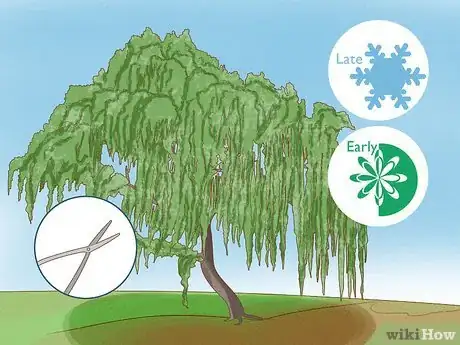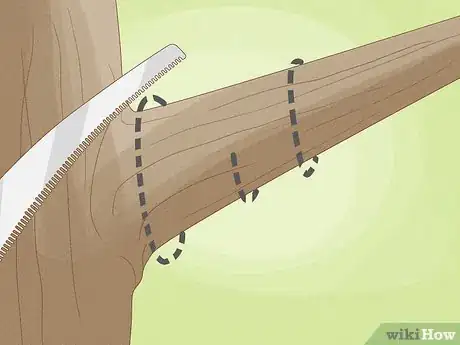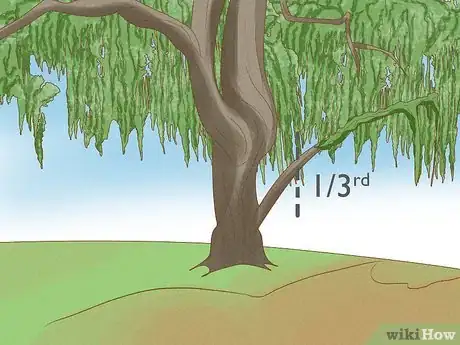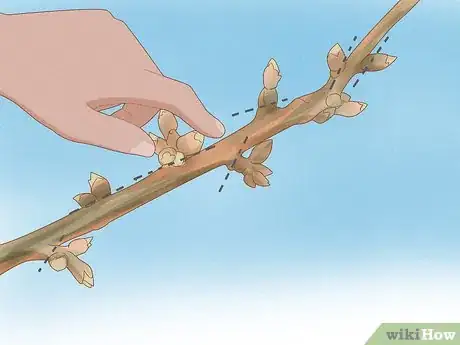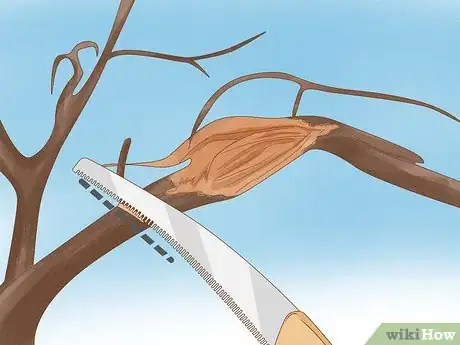This article was co-authored by Grant Wallace and by wikiHow staff writer, Janice Tieperman. Grant Wallace is a Landscaper and Owner of Grantlanta Lawn in Atlanta, Georgia. With over seven years of experience, he specializes in lawn maintenance and landscape installation. In 2012, he earned his BA from the University of West Georgia. Grant has been profiled in Shoutout Atlanta, Canvas Rebel, and Voyage ATL.
There are 9 references cited in this article, which can be found at the bottom of the page.
This article has been viewed 44,510 times.
Weeping willows are a beautiful addition to your yard or property, and are well-known for their long, “weeping” branches. While these trees don’t require a ton of maintenance, they can get overgrown easily, and may require a bit of pruning now and then. Grab a pair of pruning shears or pole pruners so you can keep your tree as healthy and vibrant as possible!
Steps
How and When to Prune
-
1Prune your tree in late winter or early spring. Weeping willow trees tend to thrive during warm weather, and will be in full bloom then. If you prune a willow tree at this point, a lot of sap will leak out, which isn’t great for your tree. Instead, wait until winter to prune the branches.[1]
- You can also prune your tree in very early spring.[2]
-
2Get your pruning done with pruning saws, shears, or pole pruners. Thankfully, you don’t need a lot of special equipment to prune your weeping willow. Look through your tools for a pair of pruning shears, and possibly a pruning saw or pole pruner. If your weeping willow is fully grown, some of the branches may be difficult or impossible to reach without a pole pruner.[3]
- A pruning saw can help cut off thicker branches and growths.
Advertisement -
3Cut back branches at an angle. Sometimes, pruning a weeping willow only involves trimming off a small section of the branch. In this case, cut the branch at a 45-degree angle, which will help the tree heal more quickly. Place these cuts at least 1⁄2 in (1.3 cm) above any buds on the branch that you’re pruning.[4]
- Only use this angled cut on thinner branches, instead of thick limbs attached to the tree.
-
4Use a 3-part cut to remove heavier branches from the tree. Start by sawing into the lower half of the thick branch, which is known as an undercut. Then, saw through the top half of the branch, which is known as a topcut. Once the bulk of the branch comes off, saw off any leftover wood, or “stub” with your pruning saw.[5]
- Make the stub cut right along the side of the tree, where the bark along the end of the branch forms a “ridge.”
What to Prune
-
1Trim off any stems that are protruding from the central one. If your weeping willow is very large and expansive, there may be more than 1 central stem in the tree, which can create a lot of tangling and overgrowth. Find the largest, sturdiest stem in the middle of your tree, which will serve as the base of your pruning.[6] Grab a pruning saw and cut off any extra growths from the central stem, even if they’re big. This can be a big undertaking, so be sure to give yourself plenty of breaks while you work![7]
- If your weeping willow only has 1 central stem, you don’t have to worry about this.
- It may help to create a “waste” or “trash” pile, where the old branches and growths can go.
- It’s easiest to do this when your tree is young or newly planted.[8]
-
2Snip back ⅓ of a branch if it’s dangling too close to the ground. In some cases, you won’t need to cut off an entire branch. Instead, you can cut off a smaller section.[9] Grab a pair of shears of pole pruners and cut off the bottom third of any long, overgrown branches. Repeat this process with any overgrown or ground-level branches.[10]
- You don’t have to trim down your branches, but it can be useful if you enjoy sitting or lounging beneath the willow tree.
-
3Trim off any intertwined branches from the base of the tree. Cut back growth by checking for branches that have intertwined, or are currently rubbing against one another. Start with the smaller, overlapping branches, then work your way up pruning the larger tangles.[11]
- Working from small to large will make your pruning job a lot easier.
-
4Cut back branches so they’re 2 in (5.1 cm) apart. Weeping willow trees can get overgrown easily, which can affect the amount of air circulating through the branches. Examine the branches towards the top of the willow tree, making sure that they’re at least 2 in (5.1 cm) apart. It may take a bit of extra work, but spacing out these branches will help make your tree a lot healthier.[12]
- Overall, check that the tree’s “crown,” or top, looks balanced and not overly dense.
-
5Rub away any new growths as soon as they appear. Weeping willows tend to develop “lateral growths,” or extra growths peeking out from the side of the trunk. Examine the tree every so often to check for these extra growths. You can usually remove them by rubbing or pinching them off the tree.[13]
-
6Remove hurt or broken branches as you notice them. Look for any branches that seem tired, sickly, or like they’re about to fall off the tree. Prune these off quickly, which will help your tree become healthy and strong.[14]
-
7Trim away any root suckers from the tree. Look closely for any small, thin branches protruding from the very bottom of the tree. Cut root suckers away at the base, so they can’t steal any nutrients from the rest of the tree.[15]
- Root suckers can mean a few different things. They can signify that your tree is getting old, or they might be a sign that your willow is fighting a nasty disease. If your weeping willow is generating a lot of root suckers, you might want to consult a landscape professional for guidance.
Things You’ll Need
- Pruning shears
- Pole pruners (optional)
- Pruning saw (optional)
Warnings
- Crown gall is a common disease that weeping willows can get, which looks like ugly red bumps that form along the base of the tree. If your willow tree looks like it has crown gall, call in a professional to remove the tree.[17]⧼thumbs_response⧽
Expert Interview

Thanks for reading our article! If you'd like to learn more about gardening, check out our in-depth interview with Grant Wallace.
References
- ↑ https://www.treesaw.co.uk/pruning-willow-trees
- ↑ https://www.thisoldhouse.com/gardening/21332451/weeping-willow
- ↑ https://aggie-horticulture.tamu.edu/earthkind/landscape/proper-pruning-techniques/
- ↑ https://aggie-horticulture.tamu.edu/earthkind/landscape/proper-pruning-techniques/
- ↑ https://extension.purdue.edu/extmedia/FNR/FNR-506-W.pdf
- ↑ https://www.thisoldhouse.com/gardening/21332451/weeping-willow
- ↑ https://extension.purdue.edu/extmedia/FNR/FNR-506-W.pdf
- ↑ https://www.thisoldhouse.com/gardening/21332451/weeping-willow
- ↑ https://www.johnson.k-state.edu/docs/lawn-and-garden/in-house-publications/garden-maintenance/Pruning%20Weeping%20Trees%20and%20Shrubs.pdf
- ↑ https://extension.purdue.edu/extmedia/FNR/FNR-506-W.pdf
- ↑ https://www.johnson.k-state.edu/docs/lawn-and-garden/in-house-publications/garden-maintenance/Pruning%20Weeping%20Trees%20and%20Shrubs.pdf
- ↑ https://www.johnson.k-state.edu/docs/lawn-and-garden/in-house-publications/garden-maintenance/Pruning%20Weeping%20Trees%20and%20Shrubs.pdf
- ↑ https://www.johnson.k-state.edu/docs/lawn-and-garden/in-house-publications/garden-maintenance/Pruning%20Weeping%20Trees%20and%20Shrubs.pdf
- ↑ https://extension.umn.edu/planting-and-growing-guides/pruning-trees-and-shrubs
- ↑ https://www.loveyourlandscape.org/expert-advice/tree-care/insects-and-disease/dealing-with-tree-suckers/
- ↑ https://m.youtube.com/watch?v=Ha55Mnf_1r0&t=1m19s
- ↑ https://edis.ifas.ufl.edu/st576
